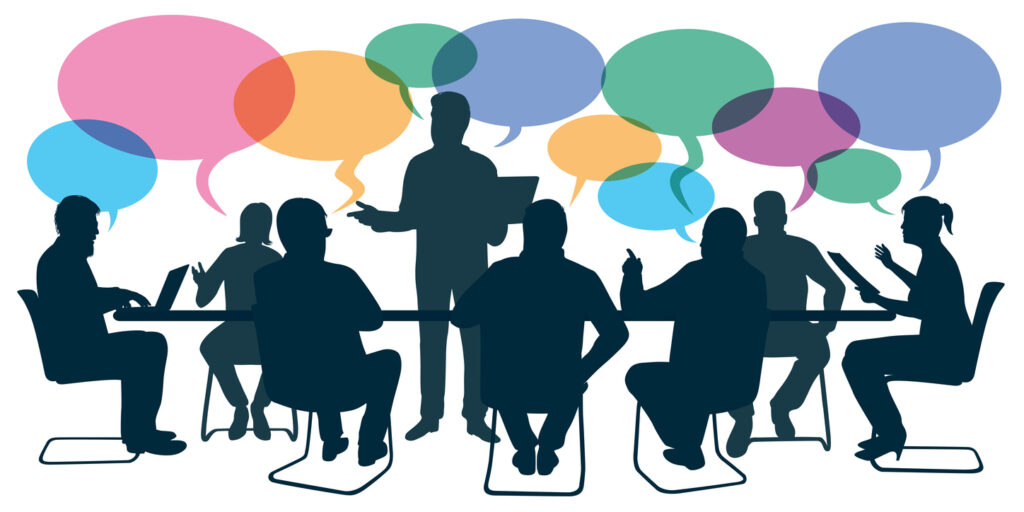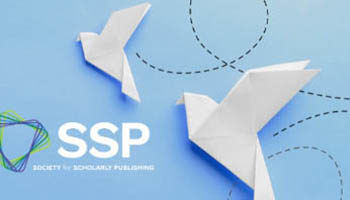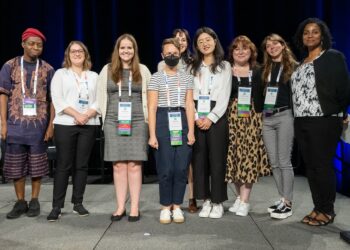Editor’s Note: Today’s post is by Matt Cannon, Heather Staines, and Jordan L. Schilling. Matt is Head of Open Research at Taylor and Francis. Heather is Senior Consultant at Delta Think and President for the Society for Scholarly Publishing. Jordan is the Publishing Director for Springer Medicine journals at Springer Nature.
Planning is now underway for the Society for Scholarly Publishing’s (SSP’s) 2024 New Directions Seminar (NDS), which will take place in Washington DC on October 1 and 2. This made us mindful of last year’s seminar where the three of us organized a “reverse roundtable” session to initiate discussions between delegates on the hottest topics of the day.
What is a reverse roundtable session, I hear you ask? Well, attendees in person were seated at 10 round tables, and a roster of expert facilitators were arranged to cover five key areas of the publishing process. A facilitator joined a table and led a discussion related to their expertise. When the 20-minute timer sounded, the facilitators all stood up and moved around to the next table for the next period… and so on! Sound complicated? Well, once we planned it out (complete with visuals) it was fairly straightforward. Also, we replicated the whole process for the online delegates using Zoom! (Spoiler alert: We needed several scorecards to keep track – but our attendees barely had to move a muscle!)
While this organizational feat alone may be worthy of a post on The Scholarly Kitchen, we wanted to share more about the topics and takeaways from this process and how the format influenced the discussions that took place.

First, the conversations were grouped into five broad areas intended to reflect all parts of the publishing process with three experts per area which covered the in-person and online attendees. We held online planning calls with each group to cover highlights and create “discussion prompts” that the facilitator could choose depending upon what the particular composition of their table might be (more beginner, more advanced, mostly from outside the topical area, librarian perspectives, etc.). If you are interested in learning more, the planning documents for each (along with rough notes from the discussion) are linked below.
- Editorial, Strategy, Business Models
- Cheryl Johnson, APA, Associate Publisher
- Dax Rodulfa-Blemberg; American Society of Hematology; Deputy Director, Editorial
- Christina Rudyj, American College of Physicians, Director of Electronic Publishing & Product Development
- Peer Review & Research Ethics
- Lillian Selonick, Proceedings of the National Academy of Sciences, Assistant Managing Editor
- Brian Solis, AIP Publishing, Senior Journal Manager
- Kendall Mckenzie, Frontiers
- Submission, Production and Publishing Tech
- Anna Jester – eJournal Press, Wiley
- Shelby E. Jenkins, American Psychological Association, Dir of Book and Journal Production
- Kristen Swendsrud, American Academy of Neurology, Production Coordinator
- Content Indexing, Dissemination & Archiving
- Kay Burrows – Taylor & Francis
- Dylan Ruediger, Ithaka S+R Program Manager
- Jen Gibson, Dryad
- Marketing, Promotion, & Engagement
- Ashlina Chin, NAS/PNAS, Content Marketing Manager
- Neen LeMaster, American College of Gastroenterology, Editorial Coordinator
- Chelsea Tharp – BioOne
All of our experts had three 20-minute conversations with delegates during the session. And all attendees had the opportunity to discuss three of the five areas, roughly in the order that they impact the publication process. We’ve gathered their reflections on the structure and content of their groups, and also asked some of our attendees to comment on their experience.
Were your three discussions largely similar to each other, or was each unique? Why do you think this was the case?
- They shared significant common ground, but each had a distinctive flavor depending on the composition.
- Some similar themes came up for each, but the conversations as a whole were quite different.
- Each table had a different mix of organizations and job functions, so the discussions varied as people participated from different perspectives.
What are your biggest takeaways from the meeting?
- That AI is on the horizon for publishing at large, but at least thus far, we seem somewhat underequipped to face both the challenges and opportunities that we’re encountering now and may encounter in the future. I would love to see the AI talk among the industry at large be turned into action. I would like to see more concrete “guardrails” being developed, but would also like to see more publishers and societies using AI to improve processes/workflows/overall experience for authors, editors, and staff.
- It was interesting to see how everyone was thinking about the same major topics that are a constant point of conversation in my daily work. It was great to be part of a community at NDS with people sharing their experiences on the changing landscape of scholarly publishing.
- People can have very similar concerns, fears, and excitement about the current state of publishing, changing business strategies, and technology development.
We also asked our facilitators for advice for others looking to use the reverse roundtables format:
- Prompts are your friend to keep the conversation going. It is also very helpful to pay attention to previous conversations that will continue in discussions in order to better facilitate.
- Keep it natural and genuine, and don’t worry too much about following a particular plan and formula. It helps to have some prepared questions to start with so that the conversation gets rolling, but from there, it’s enjoyable and rewarding to let the group direct the conversation and let it lead down whatever interesting and fruitful paths might arise naturally.
- I would recommend that you come prepared with talking points and questions, but be flexible to allow the groups to dictate where the conversation will lead. It was great to see the range of experience people have in some of the areas of conversation, such as AI and Open Access.
Reflections from delegates
The format (while complicated for us to pull off) was a definite hit!
Jennifer Regala noted, “This portion of the program was special because I saw so many different yet valuable approaches to problems we all share.” Jacob Wilcock remarked that “What I remember most from my discussions was a shared sentiment that the solution to technology problems isn’t always more technology; sometimes it’s nudging more users to adopt the technology that we already have.” Maxine Alred recalled, “At one roundtable, we talked extensively about the Open Access models and how different publishers are preparing to adopt or expand their publishing model while being vigilant of growing publishing costs.” Mike Di Natali added, “It was a tremendous opportunity and experience to rotate through different groups made of stakeholders from organizations with different perspectives than mine, all trying to address the same concerns and issues that publishing faces today.”
Rotation did more than keep attendees awake after lunch:
“What was amazing is that the method enabled each of the small groups to discuss all of the big issues, rather than having to pick just one,” noted Bill Kasdorf. Christine Orr added, “As each facilitator arrived with a new topic, we got to address it in the context of what we had just learned about our tablemates, or expand on our own previous remarks.” And Simon Holt, a first time NDS attendee, replied that the format gave them “an opportunity for us to build on each ‘mini-session’ as a small group as we got to know where each person in our group was coming from.”
New faces, new voices – new friends!
Lauren Kane, who was very helpful in recruiting the facilitators, highlighted that, “It was an excellent touch to have them moderated by new community voices.” And Ginny Herbert, a champion at finding facilitators who hadn’t presented at NDS before, added that “At the end of the conference, a big group of us went out to lunch and continued some of the conversation and debate we were having at the roundtables!”
To summarize, the session was a useful format to instigate discussions on key areas of the publishing process in good-sized groups across roles and companies. Attendee Michie Gluck responded enthusiastically, “This was my first experience attending a New Directions seminar and I hope to attend another in the future!”
Thanks to all the facilitators (online and virtual) and the enthusiastic attendees! Please feel free to reach out if you would like to replicate this format at your event. Hope to see you in October in DC!



